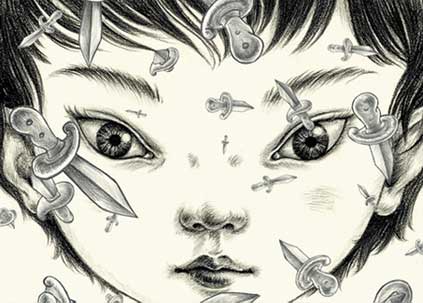
アメリカでは、タコの遊び場を見たことがありません。恵比寿で。

友人のクリス・バーテルセンが、デジタル本を二つ出しました。その一つは、子供の視点で、東京の路地を探ります。おもしろい話や地図や写真と一緒に、都市生活を新鮮な視点で見ています。もう一つは、クリスの息子のとんか君が、家の近くに居るクモの観察をする、という内容です。日本語と英語で書かれています。よろしくね!
My super-prolific friend Chris Berthelsen has released two small self-published stories. The first is “Child Scale” or “Rainy Day Treasures” about how Tokyo streets look, smell, and feel for kids. Chris’ writing, mappings, and photographs follows a rainy day walk to the local public bathhouse with a four year old. It’s a rich observation and reflection on play and creativity. The street is the ultimate shared space in our cities, for a variety of ages, walking and transit. After reading Child Scale, I’ll pay more attention to the “floorscape” than my usual rushing or daydreaming.
Child Scale is just $3.50. You get a 112 page download, with A5 print and screen resolution PDFs. The Huffington Post and Atlantic Cities have already referenced this digital booklet. It will be enjoyed by those wanting to think more about Tokyo, urbanism, children, play, and creativity.
 The second booklet is by Chris’ son Tonka, who writes about his Tokyo Spider Research. It’s a 19 page booklet that examines spiders found inside and nearby a Tokyo apartment. Tonka’s handwritten notes and photographs provide a detailed document about some of the small creatures sharing our urban lives. The booklet is in Japanese and English, and will certainly inspire you to look more closely at the あimmediate environment around you. It’s just $2 for the download.
The second booklet is by Chris’ son Tonka, who writes about his Tokyo Spider Research. It’s a 19 page booklet that examines spiders found inside and nearby a Tokyo apartment. Tonka’s handwritten notes and photographs provide a detailed document about some of the small creatures sharing our urban lives. The booklet is in Japanese and English, and will certainly inspire you to look more closely at the あimmediate environment around you. It’s just $2 for the download.


It’s hard for people outside Tokyo to imagine what using Tokyo transit is like. The busiest station, Shinjuku station, handles over 2.5 million users per day, more than any other station in the world. And, yes, early morning rush hour and the last trains around midnight are not comfortable. This photo is from 10:23 am on a Saturday morning in the Marunouchi line, and you can see that the train is quite full.
What does it feel like to be surrounded by so many people on your way to work, school, errands, or fun? Office workers, school children, families, construction workers, teens, dogs in bags, babies, elderly people. I find it exhilarating, intimate, and educational. Mostly people pretend they are in their own space and do not look directly at others. Courtesies include taking children’s shoes off before letting them stand on the cushioned seats, and drying umbrellas to keep the train clean.
Many people hide behind earphones, portable game players, comics and books. Others are sleeping. Yet there is no mistaking that you are in a shared space, one person among masses going about their lives. If you keep your eyes open, you can sense that others are also quietly observing. Taking the train is a good way to get out of your own head space, and sense other people’s moods, fashions, and presence.

Tokyo’s great transit system allows you to go many places without a car. You can enjoy the scenery and meeting many people.
電車がたくさんあるので、車なしでいろいろな所へ行けます。多くの人に会えるし、きれいな景色を楽しめます。
The days are getting shorter, and with clearer skies the sunsets are remarkable. Recently I have been enjoying the views from elevated trains and stations. Trains in Japan are always punctual, clean and efficient. And apart from peak commute times, you can relax and enjoy the peacefulness of leaving the driving to others. Tokyo’s superior urban transportation system allows for a city where private cars are not the main form of mobility. It is still surprising to me how much walking, biking, conversation, playing, and reading dominates Tokyo’s many small streets, with the occasional car slowing down to pedestrians’ pace.


On my Meguro walk, I noticed two pocket parks, one newer and one older. Both have a similar plan: wide open space with gravel, and minimal plants, play areas, and seating. I know that one reason Tokyo parks are created this way is to provide a gathering space for emergencies. Yet if emergencies are an every 10, 20 or even 50 year experience, wouldn’t it make more sense to get better use out of the parks in the meantime? In an emergency the plants could be justifiably trampled, but at least they would provide more active natural environments for daily life.
During my weekday visit, I noticed two office guys taking a smoking break (separately), a senior taking a rest, and some high school kids on their cellphones. It would be great if there was also room for vegetable growing, butterfly gardens, bird watchers, and wildlife habitat.



In urban settings, shrines and the entrances to cemeteries are open all day and night. Especially at night, they provide equal doses of nature and mystery that is both within and separate from normal urban life. These long exposure photos capture some of the magical beauty of nighttime trees, plants, shadows and stones.
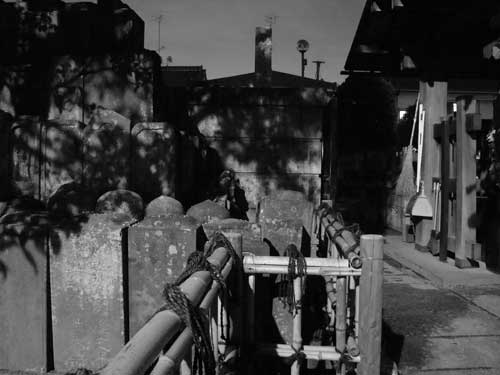
This experience in a nighttime cemetery reminds me of a term I recently learned from a Tokyo University professor who works at Hakuhodo: harappa (原っぱ). Harappa is an in-between urban and wild place that traditionally allowed children a space to play and explore. It could be a meadow, a grove of trees, or an abandoned building. With ever increasing construction and denser urban lives, these liminal spaces are harder to find. Shrines function as one of the most solid barriers against total urbanization.
A small tip: I recently learned how to take crisp nighttime photos with an inexpensive digital camera. To avoid shaking and blurring from long exposures, use the timer and set the camera on a hard surface.
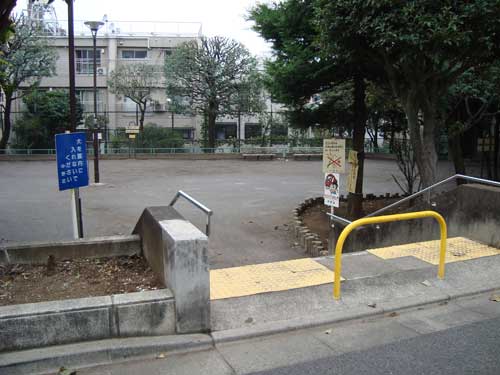
I am struck by how poorly maintained and under-used many of the residential neighborhood parks are. This one, close to where I live, is large, has many mature trees facing the street, and has almost no usage. To call it uninviting and unloved would be an understatement.
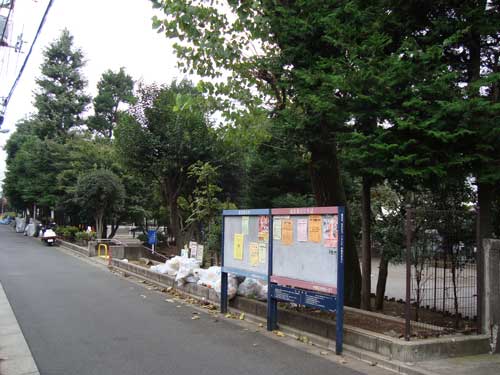
The street side is almost promising. There is a long row of mature trees and a community bulletin board. Next to the bulletin board, and also on the far end of the park, are designated areas to leave your trash. Unfortunately, there is no receptacle for the bagged garbage, so crows and cats pick through the bags and the contents start to disperse.
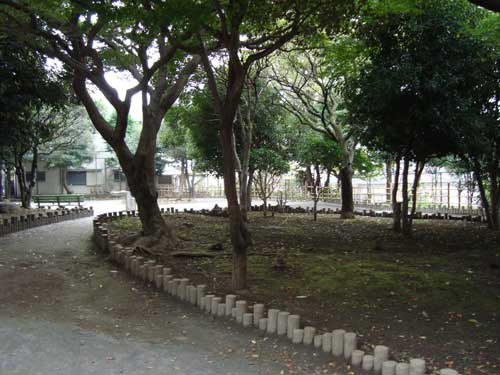
The entrance to the park reveals vast areas of gravel, unplanted beds, and few amenities or attractions. The size of the park only underscores the waste of so much public space going unused. Given how avidly neighbors tend to their tiny gardens and occupy small strips of public space, why are local governments unable to harness this human resource for beautifying and maintaining public space?
I can imagine many other uses for the park: community vegetable gardens, flower contests, rice field, bee hives, food stand, children’s play area, public art-making space. Given limits to local government budgets, maybe there would be a way to attract corporate sponsors and neighborhood volunteers. If more people were attracted to enter the park, I am sure it would be cleaner and more inviting.
After the jump is a photo inventory of the current park assets, mostly aging structures with a surprising amount of trash. During my visit I noticed a small garden crew and two people on a bench.
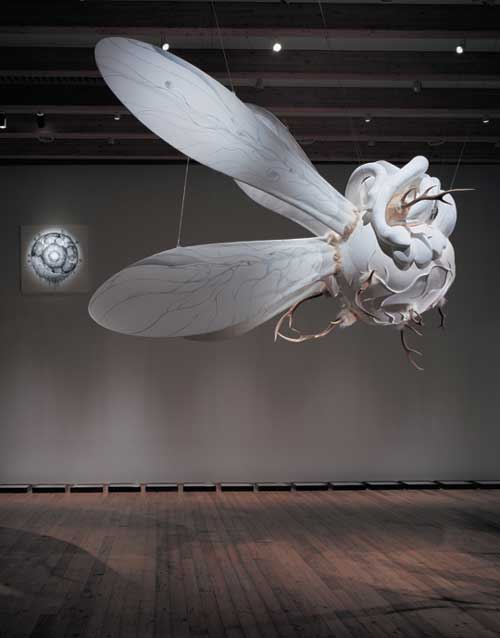
I recently visited Konoike Tomoko’s (鴻池朋子) immersive retrsopective show called Inter-Traveller at the Tokyo Opera City Art Gallery. Presented as a child-like journey to the center of the earth, Konoike’s art creates a universe of myths in which nature and humans become merged in fantasy: six-legged wolves, wolves and butterflies with young girl’s legs and red running shoes, volcanoes with human faces, a fuzzy ball character with legs and no head, a giant ball with antlers and wings and human birth, swords, and giant books.
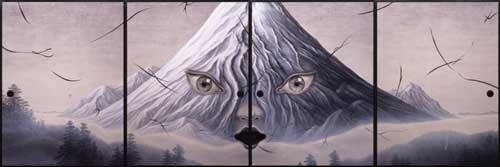
This first comprehensive exhibit include pencil on paper, painting, fusuma screens, installations, animations, and sculpture. Some rooms are entered by very low passage ways, and the second to last room has a giant spinning baby’s head covered in mirrors, surrounded by mariners’ ropes and broken glass. The movement of light around the room made me hold on to the railing with intense vertigo. The final room almost forces the visitor to confront nature and death in a tangible way; fortunately there was a discreet side escape for the squeamish.
I mention Konoike’s work because her wonderous myth-making projects a vision of humans in a state of crisis and seeking meaning through nature, mystery and travel. Just as some argue that most agricultural invention and technology comes from cities, I felt that Konoike’s art, while drawing on the natural world and spirits, is deeply urban and contemporary. The journey to the center of the earth and to rebirth, she suggest, involves imagination, play and communication between the living and the dead. I was not surprised to learn that her atelier is in one of the world’s most urban locations, Akihabara, and that her background includes toy and character design along with fine arts.
